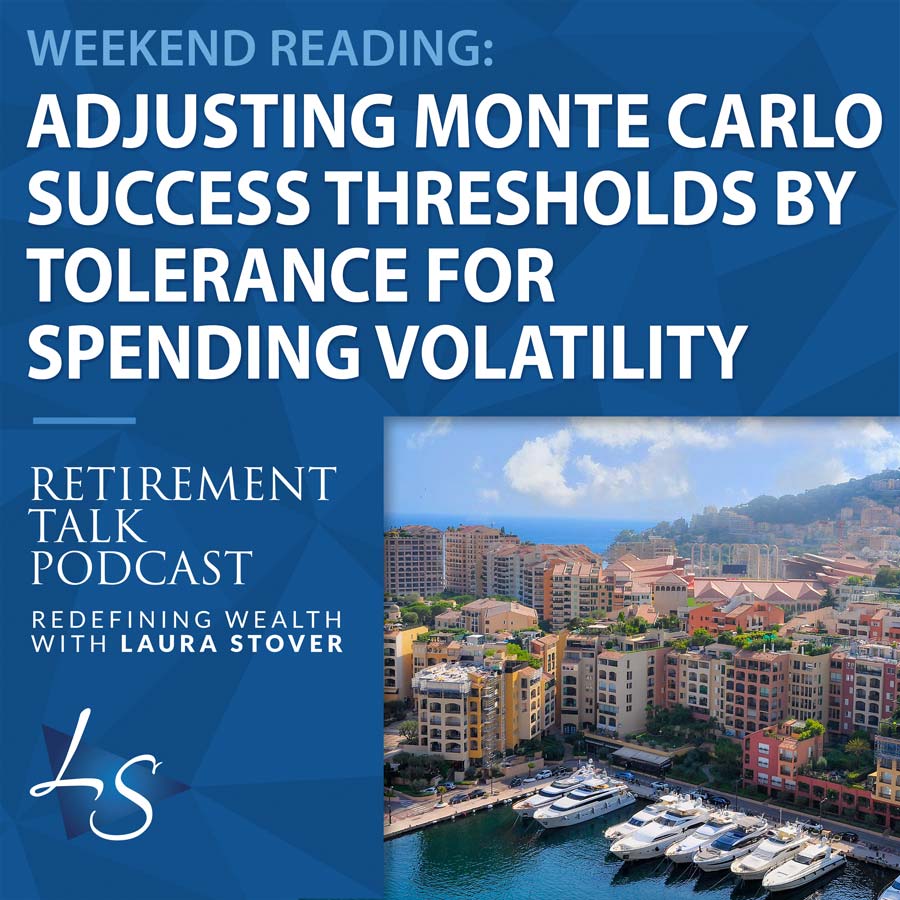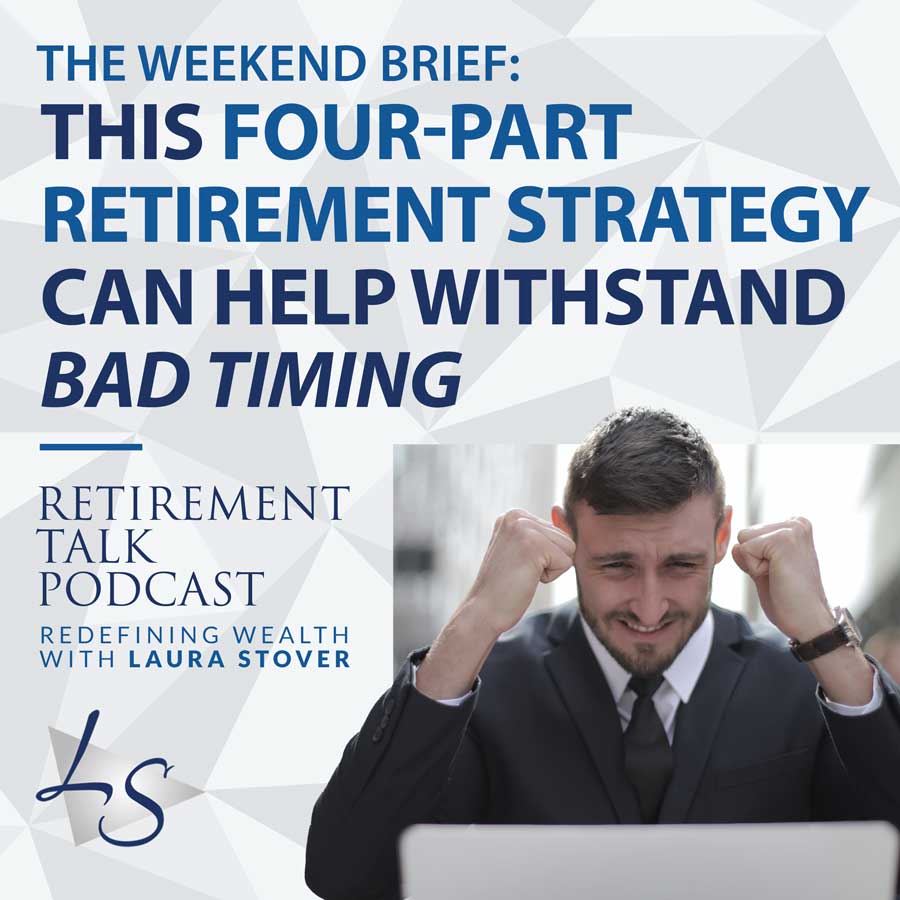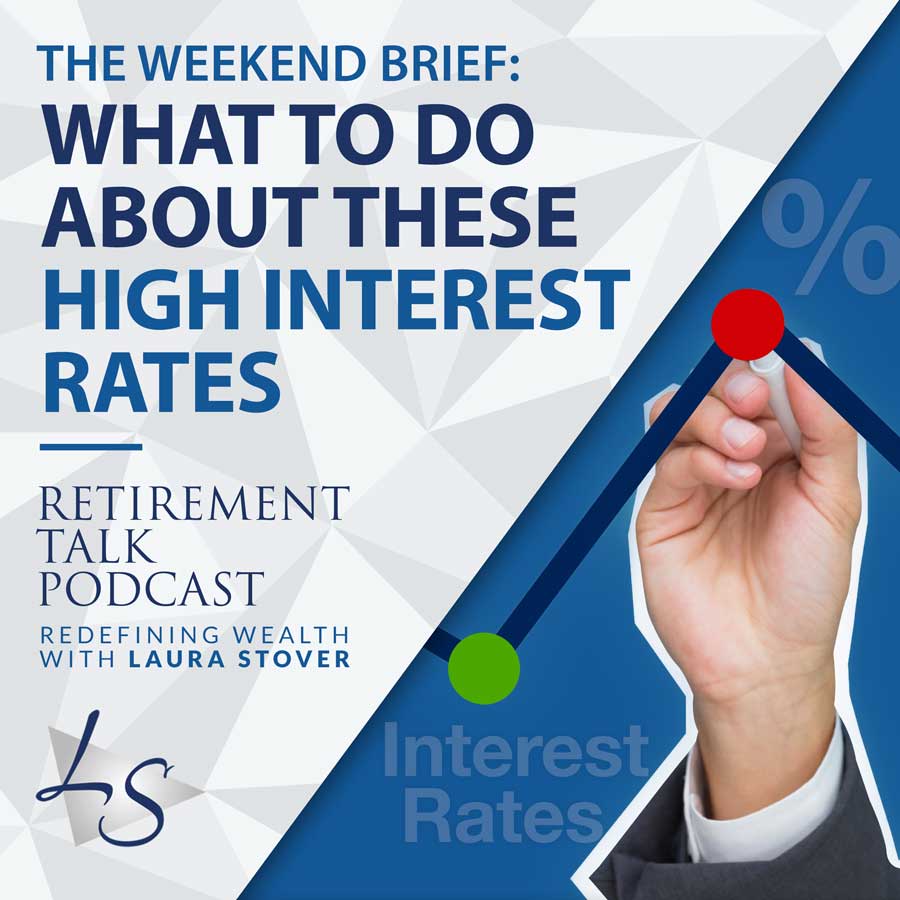Have you looked into the odds of success with your financial plan? In this episode, we’re exploring the Monte Carlo Success Thresholds, highlighting adjustments in tolerance for spending volatility, and sharing three questions you should be asking yourself as you think through every situation in your retirement planning.
Review the article mentioned in today’s show >>
Rate & Review the Podcast on your favorite podcast app!
Show Notes:
Volatility Tolerance (2:47)
What is the probability of success? (5:08)
Risk Tolerance & Volatility (15:06)
Behavioral Finance (17:29)
Building Bond & Equity Positions (19:29)
Scenarios & Variables in Retirement Planning (21:23)
Questions to Think Through Planning Situations (22:24)
Question 1 (23:07)
If market performance over the next three years is well below long-term expectations requiring you to take corrective action by reducing some adaptive expenses, how would you perceive this outcome?
A: unfortunate, but part of the nature of planning and uncertain world conditions
B: disappointing, something you’d like to avoid if at all possible
C: unacceptable the result of a poor plan
Question 2 (24:19)
If market returns are poor over the next three years, let’s consider which response:
A: Modify my financial goals to create a more feasible plan
B: Lower some of my adaptive spending items to get back on track
C: Accept a higher level of market volatility to improve expected returns
D: I would not be comfortable with any of the options above.
Question 3 (26:04)
Complete the statement: I should only expect to modify my spending if the market falls ____ percentage or more.
Links
Schedule a Review: https://redefiningwealth.info/schedule/
Listen & Subscribe
Ron Stokes:
Welcome to Retirement Talk the redefining wealth show, your source for financial information for pre-retirees and retirees to help you better navigate during these financial times. We are here to discuss thoughts and ideas with some of today’s foremost experts in the field of finance and retirement, as well as discuss trending topics and the impact of major legislation that can impact your bottom line. We will break it all down. These discussions can help you make better financial decisions and be informed so you can live the lifestyle you imagine and make better financial choices.
Ron Stokes:
Laura Stover is a registered financial consultant and CEO of LS Wealth Management, as well as Founder and Owner of LS Tax, a consulting firm. She’s been featured in Forbes, CNBC and The Wall Street Journal. I’m Ron Stokes. Our topic for today comes from Michael Kitces. If you would like to learn more on today’s topic, head on over to redefiningwealth.info. Schedule a strategy session with Laura Stover and certified financial planner, Michael Wallen, or check out show notes and archives of all shows redefiningwealth.info. Now, here are your hosts for today’s show wealth advisor, Laura Stover, and Certified Financial Planner, Michael Wallen.
Laura Stover:
Hello. Hello. Hello. I am joined today by my good friend and certified financial planner, all around great guy, Michael Wallen here with me today. Hey Michael.
Michael Wallen:
Wow, I thought my mom was the one giving that intro. She’s the only that gives me those kind of accolades. Thank you so much for that intro, Laura.
Laura Stover:
I mean every single word, Michael. I like the article that we’ve chosen for today that we’re going to share with everybody, but surround yourself with great people no matter how overwhelmed you feel in the day and I’m going with my friend and telling her all these things that’s going on in my busy, busy world these days and she simply said, “Look at all the great things that you’re accomplishing.” And not to feed my ego or anything, but the good that’s being put out, and this is a time of year with the holiday season, we’re coming at the end of the year, we have a new year before us. The last two years have been very challenging for some people and I love the article, the discussion for today. It’s a little bit of a academic type of article. Now, I know podcasts are supposed to be fun and entertaining and we’re going to make the title of this article by my favorite blogger, Michael Kitces.
Laura Stover:
He is well known in the financial world. He’s very much a deep thinker in the title of our topic of discussion, Using Volatility Tolerance to Refine Monte Carlo Thresholds. Is that not a mouthful to discuss? But this is so relevant and it’s one of the trending topics. If you want to read more, go to the show notes, hop on over to redefiningwealth.info and I’m going to break down some of the key takeaways today, give our listeners some things to think about, take back to your financial advisor if you’re not receiving this level of information. And better yet, I hope you can begin implementing some of the important concepts that Michael and I want to discuss into your own financial life. Maybe you’re thinking of retiring soon, maybe you’re doing it yourself, this shows very much for you if you are a do it yourself investor. Remember, you can always connect directly with us, go over to redefiningwealth.info, get the link to the show notes and this one comes to us from, as I said, Michael Kitces, the tolerance for spending volatility.
Laura Stover:
He gets a little deep into the weeds, but this is some of the best information and I think it’s being put out to financial advisors, so we want to break this down to the listeners and it’s all revolving around what are your odds of success with your financial plan? That’s what the topic is centered around, Michael, and we want to determine what the odds of success are. And more importantly, what does that mean? A 90% chance of success, a 50% chance. The article actually illustrates how you could enter retirement with a 50/50 chance of a plan actually working out and still making it work out in the end. What do you have to do to increase your odds above 50%? Having a better conversation, maybe having a better handle on what you’re going to do if volatility hits the stock market, which inevitably it will. This is pretty much testing against what a lot of do it yourselfers really get wrong.
Michael Wallen:
Laura, one of the essential parts of our first pillar, which is income planning on the LS wealth process there, is really diving into this and that is what is the probability of success that we are going to have based upon the solutions that we put in place? Now, 90% typically is that threshold. Anything more than 90%, you typically get into a little too conservative of a retirement planning strategy, but we want to know that if we have the ability to at least… if we had nine out of the plans we put together and then on that 10th plan, what we’re looking at is what is that individual’s ability to modify their spending habits? And that’s a part of this article that he talks about as well is how would we be able to go in there and maybe modify some of the spending? But let’s frame this up for a second and I’ve got two scenarios I want to share with you because Monte Carlo simulations, they’re a very important part of an advisor’s toolbox when we’re constructing that financial plan.
Michael Wallen:
One of it is one of the leading financial planning softwares in the country… I had the privilege of flying out to the west coast and meeting with the developer of their software. They had been very one dimensional in the investment only side of the business and really never understood the insurance and some of the annuity type products that we’ve talked about in the past. They run a Monte Carlo simulation in side of their software, just like we do through Life Ark Plan, and when were looking at that simulation, I shared with them the use of mortality credits. And we’ve talked about mortality credits in the past shows, but that’s where you’re leveraging the large pool of insurance clients when you’re talking out an income stream coming out of an annuity. By implementing under this scenario that we had put in place… And disclosure, this is not every scenario out there, it was the scenario that we ran in the office there to show as a demonstration to the developers.
Michael Wallen:
But by adding that annuity, we increased the probability of success through their Monte Carlo by 10%. We took that individual that had a 80% probability up to the threshold we desired at 90% by properly incorporating a allocation or a percentage of the dollars into the annuity, whether it’s an immediate annuity or a fixed indexed annuity with an income writer or a variable annuity with an income writer that was providing the income stream, that’s where we start balancing that. And what the Monte Carlo is doing is allowing us to test thousands of scenarios at one time to test whether or not the solutions that we are advising have the probability that we want in the future. And like you said, if they are not working with advisors that are simply selling them something, whether it’s a one dimensional as an insurance agent or one dimensional as an investment or broker dealer, and they are not actually looking at the comprehensive plan and running these scenarios, they are leaving the risk of failure on the table because they do not have the analysis to dictate the probability.
Laura Stover:
Oh boy, this is a good topic and we could probably do every show on this type of discussion because I know we really work hard at identifying goals-based planning, not just the sexy talk. Oh, taxes are going up. Yes, taxes are going up. Do we do a Roth conversion? Yeah, I’m doing lots of Roth conversions. This goes on to a much deeper, getting under the hood analysis of probability of success in retirement and having what is a well constructed plan to address it. It comes down to expenses. Cashflow and assets are a very major component. It’s not just, “Oh, I have some money. What do I invest in?” A lot of do it yourselfers, really miss the boat. They’re using simplistic financial planning software online. Now, that’s all fine to kind of wrap your head around numbers and rates of return, but simplistic financial planning software online, plug in a of a rate of return, 5%, 7%. You hear this a lot. And the stock market, it averages 10% a year, right Michael? Or I made 12% a year or I invested in crypto and I’m down $70,000.
Laura Stover:
Now, I didn’t do that, but I see people that did do that. Not putting all your eggs in one basket or looking at annualized return of a 401k statement, maybe you’re making 12%, maybe you’re up 20% because the market’s been good this year. How long will your money last? Will the market repeat itself for the next 10 years as it did in the last 10 years? None of us know the question and what the author is trying to point out here is what you’re spending now, coupled with the rates of return, how would you have to make adjustments to maintain the lifestyle that you need to and want to maintain in your retirement years if seven or 10% or whatever.
Laura Stover:
We know of the market does not perform on a linear projection. If you have 7%, 10%, the stock market average is just that, it’s an average. It’s not a line into the future. It’s going to go up, it’s going to go down, it’s going to go sideways and the market’s a bit of a roller coaster and that creates some risk. Now, as you said, Michael, there’s thousands of different market scenarios. We do stress testing on all of these factors and we want to see what is the failure rate? We want to see many, many different simulations and run those returns in different orders. You can lower your average rate of return that are higher and lower in order to figure out how many different simulations could you run and not run out of money in retirement? There’s always the benchmark used by advisors. I’m at an 80% and 85, 90%. You might have heard this. What is the target? That’s what we want to accomplish is a 90% success rate.
Laura Stover:
That’s not really where we’re coming from based on some of the way Michael frames this in the article. I mean, I think our clients want $100 success rate. I don’t want to go into brain surgery with a 70% success rate or an 85% success rate, I want to know that my expenditures and my cash flow are going to match up with my expectations and the reality if something happens that the rate of return… that my income is not solely dependent upon the rate of return that I am achieving within my overall portfolio.
Michael Wallen:
And what we have to do is get outside of the information that so often we’ve got framed into in retirement planning. For years, we’ve been told that a 4% is a safe money withdrawal rate, plus inflation being added to it. Well, those numbers over the years running the simulation has really got it down that the safe money withdrawal rate is sub 3% at this time, Laura, and when you add inflation and we know right now that we could be going into a hyperinflation scenario. So as we’re looking at these increasing costs to where our dollars are coming in, how many scenarios can we run under the conditions, the variables that we present to that portfolio, to get to that success rate? And you’re right, as a retiree, that individual is looking for absolutes. The reality is absolutes are not going to be out there, but we’ve got to put the best strategy forward, shooting for the ultimate 100%, knowing that in the event that it’s not going to be achievable, the second phase of it is how much of that individual’s budget do they have the ability to draw back?
Michael Wallen:
So for instance, if an individual is making $50,000 in retirement, and let’s just say they’re making ends meet. Their expenses are at that same $50,000, they’re a typical retiree, that they’re not saving, but they’re meeting their current scenario, inflation adjustments being met, but what happens if we go into hyperinflation and all of a sudden their expenses are now for this next year much greater? What inside of their budget do they have the ability to draw back on or to reduce their expenditures to get them back inside of that margin? And because it is, we want to get them the highest probability, but it’s also on the other side that if that scenario is not meeting their needs, what is their willingness or ability to reduce down expenses in retirement? And that’s modifying the budget.
Michael Wallen:
It’s not a one dimensional approach. We must look at all dimensions, how all things come together. Just like we talked about on one of our previous shows where long term care could be a condition that we have to look at. That’s why planning early is so important that we get a plan in place, we get a strategy because we’ve got to make for inclusion of those additional services or needs that we’re going to need in retirement and build that into the equation with that long term probability that we’re looking for.
Laura Stover:
We’re looking at this approach in terms of gauging someone and volatility, their comfort with volatility, the risk tolerance in other words. We did a show about… similar to this a few times back. Maybe you fill out a questionnaire, you find that you are moderate or you’re aggressive or you are a high risk portfolio because the Monte Carlo simulation in that questionnaire is equating two things, your risk tolerance and portfolio volatility, which ultimately leads to portfolio centric responses by the advisor and the advisor then is allocating your portfolio simply due to your risk tolerance and not actually making the connection that needs to be made. Because maybe when you’re communicating that you’re moderate, for example, you are truly trying to communicate you want to avoid a certain degree of consequences based on losses, not just the loss themselves, not just the volatility in a year to year basis, but what are the consequences of that volatility?
Laura Stover:
What are the consequences of those market pullbacks? And you say, “Hey, the consequences that I need to cut my expenses,” then maybe you’re too aggressive. For that matter, if your consequences are not willing to accept that expense cut, that’s the key. When maybe you are conservative, you said, “Well, moderate,” and it’s just really thinking through these questions from the advisor side of the table and your own side of the table in order to determine what type of portfolio is right for you. Because volatility is just that, it’s a year over year thing.
Ron Stokes:
You’re listening to the Retirement Talk Podcast with Laura Stover and Michael Wallen. For a strategy session with Laura and Michael, go to redefiningwealth.info and click review. We take a deep dive with your particular situation and walk through the redefining wealth process. We will meet with you by phone, virtually or in person. Again, go to redefiningwealth.info. Now, back to Retirement Talk, the redefining wealth show with Laura Stover and Michael Wallen.
Laura Stover:
Market volatility doesn’t necessarily equate itself to reaching your long term financial goals, it’s really more about behavioral finance and that’s something that’s so important. Are you going to panic? Are you going to panic when the market goes down? How are you going to respond when markets are down? What is the consequence of the loss? This is part of your portfolio that you need for spending in the next five years and you may have a right to panic if you’re allocated wrong. And deciding whether you’re willing to cut expenses if still going to liquidate your portfolio when the market is down, we kind of nurture conversations. We don’t get a lot of this because we really approach the total return and making sure the income is never at risk and making sure the buckets are segmented out properly. This is really, really important.
Laura Stover:
You can’t just destroy your whole financial plan when these things happen, like in 2020 and we’re in the midst of a pandemic and the market surged down 34%. Well, that’s just a blip in everyone’s memory now because it recovered so abnormally fast. Or we see some advisors just putting everyone in annuities. Not that annuities are bad, but they’re so out of balance. People make the wrong moves at the wrong time because they don’t know what their plan is.
Michael Wallen:
It definitely takes a comprehensive approach. And again, not allowing the income to be directly correlated to the volatility of the market, use income providing solutions to do that and that’s why we look at diversifying the dollars, allocating them into proper tranches to mitigate that amount of risk that is exposed and, again, providing ourself a much higher probability of success by proper planning. Now, one of the things that as this Monte Carlo and a lot of advisors out there in the industry that are one dimensional are looking at building bond and equity positions, that 60/40, 40/60 portfolio. When we’re looking at those typical constraints… And Laura, yesterday I was meeting with an individual. We were setting up a 401k plan for their business and they had looked at some different competitions. And this goes back… It’s not just that individual, it’s working one on one with an advisor. This is the same thing happening with 401ks.
Michael Wallen:
But the individual said, “Well, do y’all offer any of these target date type of plans?” And I said, “No,” and I said, “Because here’s the problem with a target date. It is a system that will automatically modify down over a period of time the amount of equity to bond as you approach closer to your retirement date.” I said, “But what happens if you have not achieved the actual amount of assets you need going into retirement and you are reducing down your ability to gain those over a five, seven, 10 year time period it’s declining.” I said, “That is not our objective to do that. We want to do comprehensive planning, looking at it, evaluating it, making adjustments where necessary to target the goal.” We often talk about pilots today. When we are looking at… If I was flying up to visit you from Nashville to Ohio, Laura, if I was flying out today, the adjustments that 99% of the time that plane is in the air, the computer is making an adjustment because wind currencies, volatility variables are pushing against the plane. 99% of the time that the plane is in the air, an adjustment is being made.
Michael Wallen:
When we go into retirement planning, going into it and through it, we have to constantly review what we’re looking at to make those simple modifications, adjustments to get back onto the plum line to achieve the ultimate goal in the future and one of the tools that we use is running these scenarios. And it’s not a scenario that’s only ran once, but we should be looking at it on periodic reviews and that way we can see, “Hey, do we need to modify this? Do we need to adjust it? Has your budget changed? Has your income changed? Have you received an inheritance? Are you paying out more dollars because maybe a loved one has came to you and is in need? Are we seeing a failing health? Are we seeing another other scenario?” Maybe you started a new business or took a part-time job. All of these variables have to be added back in to look at that Monte Carlo to say, “Are we keeping your projections on target for the highest probability of success?”
Laura Stover:
That’s so true, Michael, and oftentimes clients really are getting one dimensional financial plans when we look at what they’re doing currently in their current situation. Now, the author offers some other questions that may be very helpful to assess your willingness to make course corrections in regards to your spending. We don’t like to read questions or read here on the show, but I think these are really, really good questions to help you think through your own unique situations. Michael, what’s question number one?
Michael Wallen:
Question number one, market returns are fairly consistent over long periods of time, but are highly uncertain over short periods. If market performance over the next three years is well below long-term expectations requiring you to take corrective action by reducing some, what he refers to as adaptive expenses, how would you perceive this outcome? A, unfortunate, but part of the nature of planning and uncertain world conditions; B, disappointing, something you’d like to avoid if at all possible; or C, unacceptable the result of a poor plan.
Laura Stover:
Well, it’s unacceptable. It would be unacceptable to make significant life changes or significant expense reductions. I think if I were in that position, it would be very disappointing to say the least, but that can just turn your world upside down. I want to, if at all possible, avoid that. I wouldn’t want to say I wouldn’t be willing to cut anything, but I may find myself in the middle. I’m willing to change some of my expenses, but, boy, don’t blow up my plan, Michael.
Michael Wallen:
Absolutely.
Laura Stover:
There’d be trouble if you do.
Michael Wallen:
Absolutely. What we want to do… But how we get there is by constant review of a person’s plan and that way we don’t have surprises. Let’s move on to question number two. If market returns are poor over the next three years, let’s consider this response. Modify my financial goals to create a more feasible plan; lower some of my adaptive spending items to get back on track; C, accept a higher level of market volatility to improve expected returns; or D, I would not be comfortable with any of the options above.
Laura Stover:
I’m going to find myself probably a B. I’m going to lower some of my adaptive for my discretionary spending items to get back on track. They’re using the word adaptive rather than discretionary. There’s different levels of modality. These are my discretionary expenses, I’m willing to accept some volatility with those discretionary expenses. I’m willing to cut back, let’s say, for a degree, you might be willing to completely eliminate the country club expense, but not eliminate… I’m not going to cancel my trip to go visit the grandkids. I’m always going to want those things. So really, I like that thought process.
Michael Wallen:
I do too. I like actually sitting down and having discussion with clients and walking through these different type of scenarios. We are seeing where the money is being spent and it really forces individuals to think through and think about that scenario if it became real for them in the future and then how would they respond to that situation?
Laura Stover:
The final question, there’s a table here that we’re looking at. And again, you can go to redefiningwealth.info. We’ll have this all in the show notes and the link to the article. This one here makes you really think. It outlines the largest drawdowns for the S&P 500 in each calendar year from 1928 to 2019. They want you to complete the following statement, so another provoking thought. I should only expect to modify my spending if the market falls blank percentage or more.
Michael Wallen:
This frames up a really nice threshold. If we’re looking at it from that 1928 through 2018, the average drawdown in the market was 16% to the negative best case scenario and the drawdown of negative 6.84%, to the negative worst case drawdown of 57.51%. We saw a huge range, a drawdown of negative 6.84 to negative 57.51%, so what it’s looking at is what is the range that no changes would have to be made? But if we crossed this threshold, we have an expectancy that we would start modifying some of those adaptive expenses at that point. I think what that does is establishes a plan of action and a person can go into it saying, “Okay, I am willing to make those choices and those decisions at that time,” and I think that Michael and his program, The Nerds Eye, does a phenomenal job in really doing the analytical side, the academia side of this, because it allows us to have those meaningful conversations, pre-plan and continue to have an agreement that as we go forward those adjustments are acceptable to the client and we don’t have to make any modifications.
Laura Stover:
Yeah. We want to avoid having to cut expenses drastically because you’re in the wrong plan. I think you’re going to want to go into this article into the show notes, as I said, create a chart like this for yourself. I love the chart. This may be my favorite part of the article. Probably the biggest takeaway from the article or the tool that I think is the center piece, it shows the expense items. You put together a budget, you have all of your expenses there, your property taxes, dining out, spring break, going to the movies, the entertainment and things like that, or you can connect with us. We even go deeper and it’s much more simple with our Like Ark Plan process, walking through the redefining wealth process. We have a link, you would have your own portal, you can go in and really organize these areas of your life.
Laura Stover:
But as far as the article, this helps you to put the questions in perspective. If taxes are higher, are you going to cut on costs for prescription medications? Some of those things, you’re not going to be able to cut back expenditures on. But maybe you don’t need the trip to Puerto Rico, maybe you go to Florida instead. These are part of the provoking thoughts that I think help to really put all of the cash flow, the expenditure, what your numbers are in the bottom line between the discretionary expenses and where would you choose to cut if certain things happen? And I think the whole moral of the story, Michael, is if your retirement relies solely upon depending upon the market, that’s the wrong plan to have. I know a lot of people get thrown off by spreadsheets and pages and start thinking about the market.
Laura Stover:
It’s really out of our control and what we can actually control, the biggest thing we can control is our expenses. Knowing the expenses is what’s going to put you in a position of power and help you to understand how much of them are adaptive, how much of your core can you be adaptive with, in terms of this conversation with your spouse, who may or may hate talking about finance and the market, but they’re going to be able to relate to some of the choices that you may have to make at some point in the future. Thank you for joining us. Until next time.
Ron Stokes:
Thanks for listening to this episode of the Retirement Talk Podcast. To learn more about how we can help and to get access to today’s show notes, transcript and the resources mentioned, visit redefiningwealth.info/podcasts. Again, that’s redefiningwealth.info/podcast. Also, don’t forget to leave us a review on iTunes, if you will be so kind. The more reviews we get, the more people we will reach. And if you found this information helpful, you can bet that there are many more people who need to find out. Thanks again for taking the time to listen and be sure to tune in next week for another episode of the Retirement Talk Podcast with Laura Stover. Redefining Wealth is a registered trademark of LS Wealth Management. Take advantage of a complimentary plan, know where you stand regardless of the market, walk through the redefining wealth process and have a clear picture of the key risks you likely will face and achieve a deeper understanding of how to properly plan for these risks with the Redefining Wealth Framework. Schedule a strategy session now by going to redefiningwealth.info and click schedule.
Ron Stokes:
Redefining Wealth is a registered trademark of LS Wealth Management. Investing involves risk, including the potential loss of principle. any references to protection, safety or lifetime income generally referred to fixed insurance products, never securities or investments. Insurance guaranteed are backed by the financial strength and claims paying abilities of the issuing carrier. This show is intended informational purposes only, it is not intended used as the sole basis for financial decisions, nor should it be construed as advice designed to meet the particular needs of an individual situation.
Ron Stokes:
LS Wealth Management LLC is not permitted to offer and no statement made during this show shall constitute tax or legal advice. Our firm is not affiliated with or endorsed by the US government or any governmental agency. The information and opinions contained herein provided by third parties have been obtained from sources believed to be reliable, but accuracy and completeness cannot be guaranteed by LS Wealth Management, LLC. Investment advisory services offered through through Optivse Advisory Services, and SEC registered investment advisor. LS Wealth Management is a separate entity.












